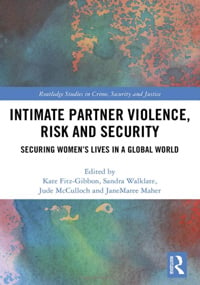Book Review: Intimate Partner Violence, Risk, and Security: Securing Women’s Lives in a Global World
Intimate Partner Violence, Risk, and Security. Edited by Kate Fitz-Gibbon, Sandra Walklate, Jude McCulloch, and JaneMaree Maher. Routledge; 284 pages; $39.96.
 Home confinement during the coronavirus pandemic has increased instances of domestic violence around the world. UN Women, a group organized by the United Nations, calls violence against women a “shadow pandemic.” According to the National Commission on COVID-19 and Criminal Justice (NCCCJ), violence against women has increased by 8.1 percent in the United States. But the estimates are much higher in other regions, including Colombia (up 175 percent), and Jingzhou, China (up 300 percent).
Home confinement during the coronavirus pandemic has increased instances of domestic violence around the world. UN Women, a group organized by the United Nations, calls violence against women a “shadow pandemic.” According to the National Commission on COVID-19 and Criminal Justice (NCCCJ), violence against women has increased by 8.1 percent in the United States. But the estimates are much higher in other regions, including Colombia (up 175 percent), and Jingzhou, China (up 300 percent).
Though it was published prior to the COVID-19 pandemic, the collection of research studies contained in Intimate Partner Violence, Risk, and Security explores intimate partner violence, particularly against women, as a global issue. Through a feminist lens, the authors effectively argue that gender violence is treated as a second-tier problem, beneath national imperatives such as terrorism prevention and response. As four of the authors conclude in the introduction, “Despite decades of feminist intervention on questions of violence against women, women’s security remains marginalized.”
The chapters fall into three categories: challenges in the contemporary global policy framework; national security, difference, and precarity; and everyday security and criminal justice questions. The section on criminal justice questions holds the most use for security practitioners, to assist in understanding context and environment, as opposed to practical advice or operational value.
Probably the most relevant research comes from the chapter “Domestic Violence Protection Orders and their Role in Ensuring Personal Security.” To fulfill duty of care obligations or otherwise, companies sometimes assist staff in obtaining such orders against abusive spouses or partners. While the chapter doesn’t delve into how companies can assist or the consequences of doing so, it sheds light on the efficacy of these interventions.
Another chapter seeks to establish a connection between climate change and intimate partner violence. The author points out that most of the world’s farmers are women, and climate change is forcing them to become migrants—who are particularly vulnerable to partner violence.
Overall, this compilation is a scholarly review of domestic violence from a feminist perspective. It packs intellectual heft and would be a great resource for academics, researchers, sociologists, and intellectuals interested in criminal justice, women’s studies, and violence. For the security practitioner, the work may be enlightening but lacks practical value.
Reviewer: Michael Gips, CPP, is principal of Global Insights in Professional Security. He has been in the security field for more than 25 years, including as an editor of Security Management and chief knowledge and learning officer at ASIS, where he remains a member.